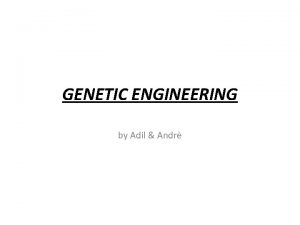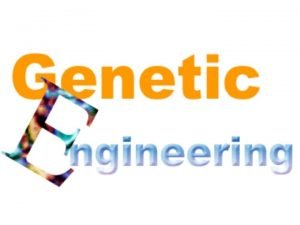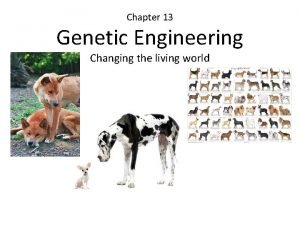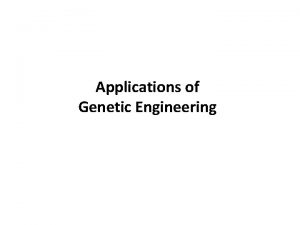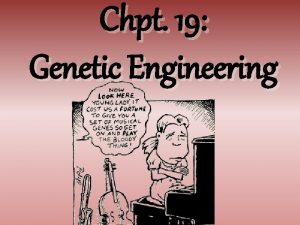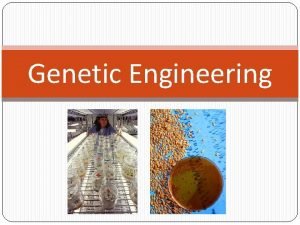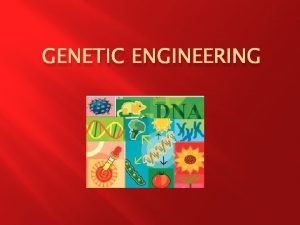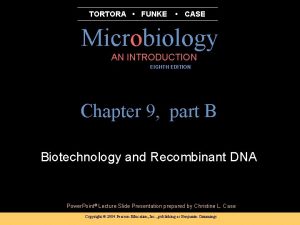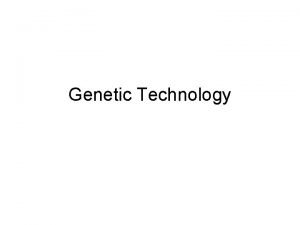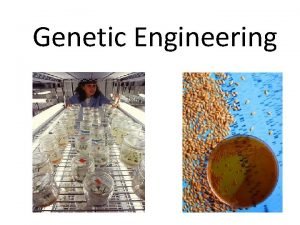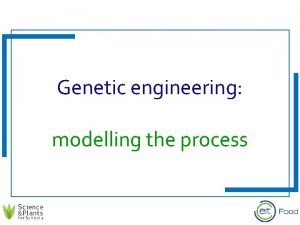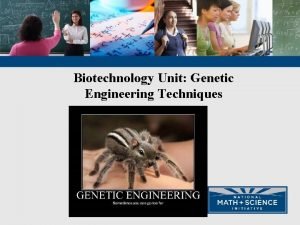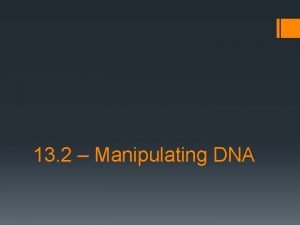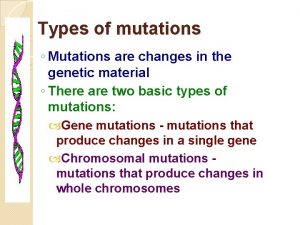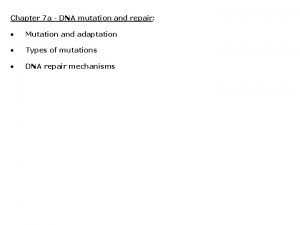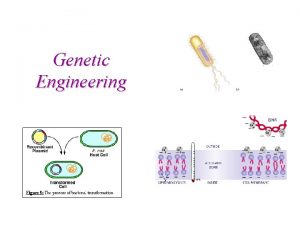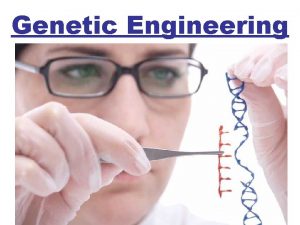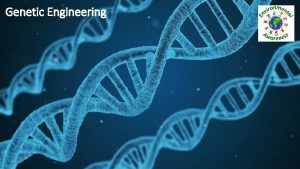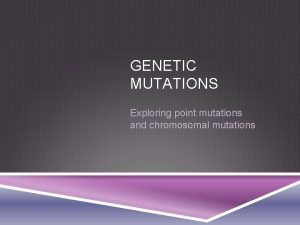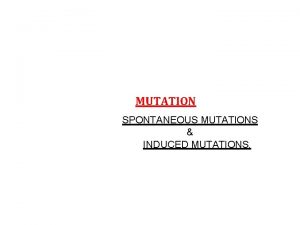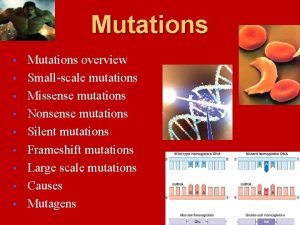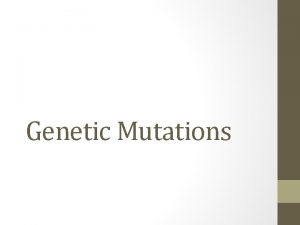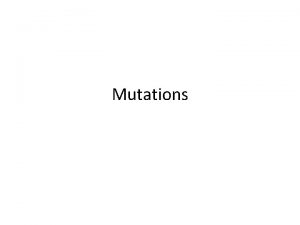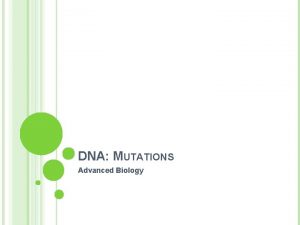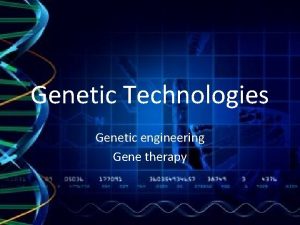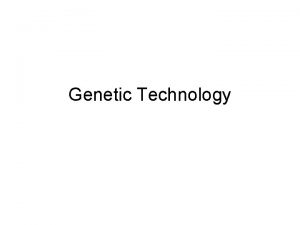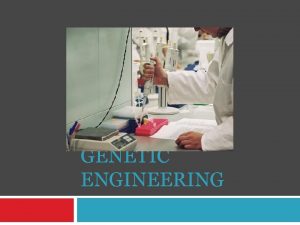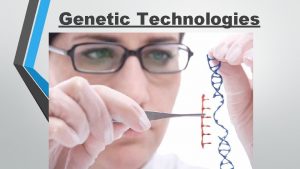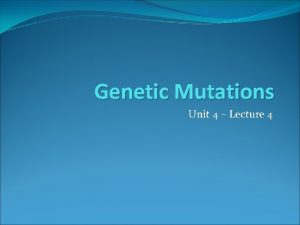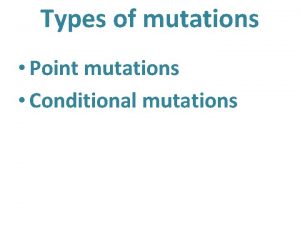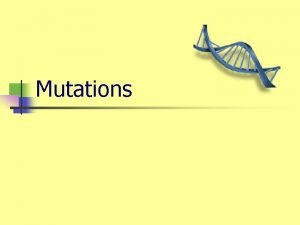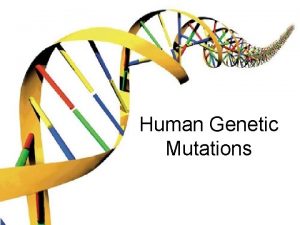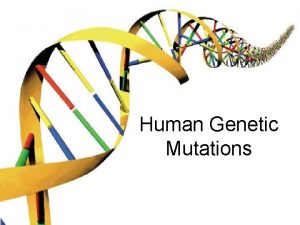Mutations and Genetic Engineering Mutations Types of mutations























- Slides: 23

Mutations and Genetic Engineering

Mutations • Types of mutations – Point Mutations or Substitutions: causes the replacement of a single base nucleotide with another nucleotide • Missense- code for a different amino acid • Nonsense- code for a stop, which can shorten the protein • Silent- code for the same amino acid (AA)


Mutations • Example: Sickle Cell Anemia

Mutations • Types of mutations – Frame Shift Mutations: the number of nucleotides inserted or deleted is not a multiple of three, so that every codon beyond the point of insertion or deletion is read incorrectly during translation. • Ex. : Crohn’s disease

Insertion Deletion

Mutations • Types of mutations – Chromosomal Inversions: an entire section of DNA is reversed. – Ex. : hemophilia, a bleeding disorder


Wrap-Up

Gene Therapy • Gene therapy is a technique for correcting defective genes responsible for disease development. • Possible cures for: – – – diabetes cardiovascular disease cystic fibrosis Alzheimer's Parkinson’s and many other diseases are possible.

Genetic Engineering • • The human manipulation of the genetic material of a cell. Recombinant DNA- Genetically engineered DNA prepared by splicing genes from one species into the cells of a different species. Such DNA becomes part of the host's genetic makeup and is replicated.

A Brief History of Genetic Engineering • The name is new, the practice is not. • Plants and animals have been bred for thousands of years. • Human breeding has also been done now and then. • All of this has worked by trying to enhance desired characteristics, without knowing how they are transmitted.

Prospects for Genetic Engineering • Designing plants & animals “from scratch” – This is not going to happen anytime soon • Transgenic Engineering – Putting genetic information from one type of plant or animal into another • Cloning – Making genetic copies of an existing plant or animal • Let’s look at the latter two of these.

Transgenic Organisms • An organism is called “transgenic” if it has genetic information added to it from a different type of organism. • Viruses do something of this sort when they infect plants, animals or humans. • Humans have begun to do this with plants and animals.

Advantages of Transgenic Engineering • Plants: – More disease-resistant – Larger yields – More transportable – More nutritious • Animals: – Make proteins for medicinal purposes – Make organs for transplant to humans

Concerns about Transgenic Engineering • Plants: – Are they safe to eat? – Will they harm wildlife? – Will some become super-pest weeds? – Replace or contaminate natural plants? • Animals: – Will they be harmful? – Replace or contaminate natural animals?

Cloning • A “clone” is a copy of something. • Computers that mimic IBMs are called “clones. ” • In genetics, a clone is a genetic copy of another organism. • Clones occur naturally: – Asexual breeding in plants & lower animals – Identical twins (triplets) in higher animals

A Brief History of Cloning • For centuries it has been known that simple animals – worms & starfish – can be cloned by cutting them in half. • This doesn’t work for higher animals! • Part of the problem is cell specialization: – – Nerve Bone Muscle, etc. We now realize that each specialized cell has all the genetic information, but much of it is turned off.

Cloning in the 20 th Century • We now realize that each specialized cell has all the genetic information, but much of it is turned off.

Dolly - 1996 • Clone from an adult sheep cell by Scots researchers under Ian Wilmut • Had only one success in 300 tries. • Dolly grew to maturity, and successfully had a lamb by natural means in 1998. • But Dolly seems to be prematurely old.

Genetic Engineering • Genetic engineering techniques are used in a variety of industries, in agriculture, in basic research, and in medicine. This genetically engineered cow resists infections of the udders and can help to increase dairy production.

Genetic Engineering • There is great potential for the development of useful products through genetic engineering • EX. , human growth hormone, insulin, and pestand disease-resistant fruits and vegetables Seedless watermelons are genetically engineered

• Genetic Engineering We can now grow new body parts and soon donating blood will be a thing of the past, but will we go too far? Photo of a mouse growing a "human ear"
 What is specation
What is specation Genetic programming vs genetic algorithm
Genetic programming vs genetic algorithm Genetic programming vs genetic algorithm
Genetic programming vs genetic algorithm What is the difference between genetic drift and gene flow
What is the difference between genetic drift and gene flow Gene flow vs genetic drift
Gene flow vs genetic drift Oryx and crake genetic engineering
Oryx and crake genetic engineering Research on the pros and cons of genetic engineering
Research on the pros and cons of genetic engineering Production of insulin
Production of insulin Section 13-1 changing the living world
Section 13-1 changing the living world Genetic engineering
Genetic engineering Cloning tasmanian tiger
Cloning tasmanian tiger Purpose of genetic engineering
Purpose of genetic engineering Source russia march
Source russia march Steps in genetic engineering
Steps in genetic engineering Bioluminescent genetic modification
Bioluminescent genetic modification Objectives of genetic engineering for class 10
Objectives of genetic engineering for class 10 Agrobacterium tumefaciens genetic engineering
Agrobacterium tumefaciens genetic engineering Genetic engineering
Genetic engineering Algenol
Algenol Genetic engineering
Genetic engineering Genetic engineering
Genetic engineering Section 13-2 manipulating dna answer key
Section 13-2 manipulating dna answer key What are some types of chromosomal mutations?
What are some types of chromosomal mutations? Types of substitution mutations
Types of substitution mutations






